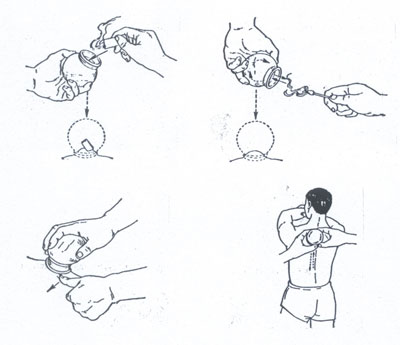Cupping Therapy for Cancer Patients
Cupping is an ancient technique that aims at inducing local congestion and blood stasis for healing. It works according to the principles of acupoints and meridians. The cups are made in different sizes and come in bamboo, plastic, glass or porcelain. The treatment consists of creating a vacuum by burning a taper inside a cup and quickly placing the cup over the selected area. TCM believes the resulting suction effect invigorates blood and qi flows, unblocks the meridians, dispels dampness and cold, and eases swelling and pain. It is commonly applied in so called Bi syndromes (bi zheng) such as lumbago, joint pain, shoulder and back pain, and is also used in the treatment of gastrointestinal disorders such as abdominal pain, or respiratory disorders like flu, pneumonia and bronchitis. When cupping is used in conjunction with TCM blood-letting methods, it can treat acute muscular skeletal sprains and some skin diseases such as carbuncles, erysipelas and psoriasis.
 |
| Cupping techniques |
Cupping can be an adjunct therapy for cancer patients, especially in pain management. For example:
| Painful locations |
Applied acupoints |
| Headache |
Tai-yang, yin-tang, feng-chi, he-gu |
| Shoulder pain |
Jian-yu, jian-liao, jian-nei-ling, nao-shu |
| Upper back pain |
Da-zhu, feng-men, jian-jing, qu-yuan |
| Lumbago |
Shen-shu, da-chang-shu, yao-yang-guan |
| Stomach pain |
Zhong-wan, liang-men, zu-san-li |
| Abdominal pain |
Tian-shu, guan-yuan, san-yin-jiao |
Cupping therapy can be take place every two days. Each time, the cups are retained in the selected areas for 10-15 minutes, 10 times for one course. There should be a one-week interval before starting another course. There will be marks or bruises left after treatment depending on the length of time that the cups are retained. Never apply on the tumor site directly.
This method is not advisable for end-stage cancer patients who are very weak. Other contraindications include fevers, general edema, convulsions, skin ulcers and those who bleed easily.
|